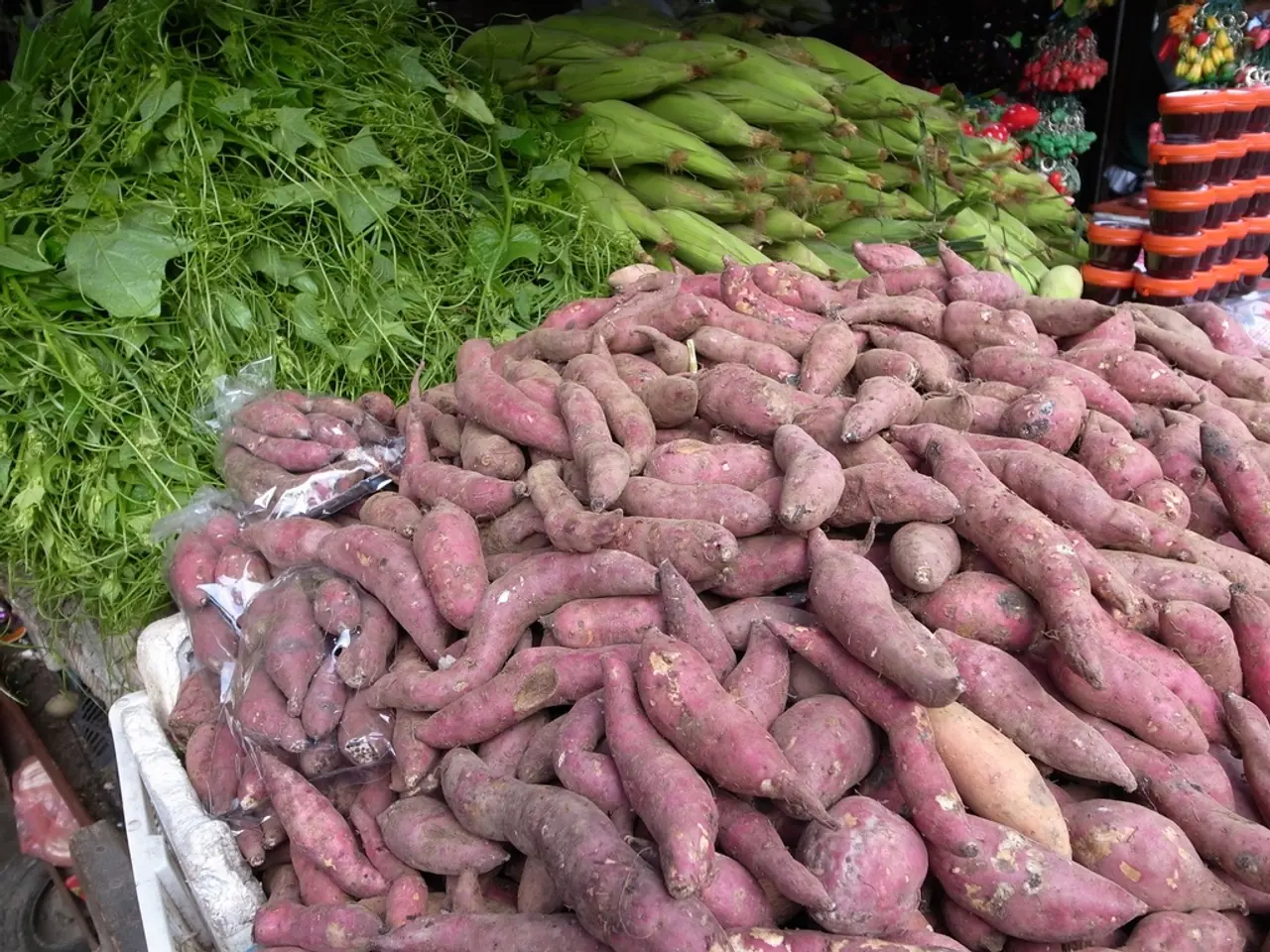Alternative choices for rice, featuring low-carb and keto-friendly options
In the quest for dietary diversity, rice substitutes have gained popularity as health-conscious alternatives. Here's a breakdown of the nutritional profiles of 12 rice substitutes, including barley, quinoa, riced cauliflower, riced broccoli, shredded cabbage, shirataki konjac rice, couscous, bulgur wheat, orzo, farro, potatoes, and sweet potatoes.
Barley
Rich in dietary fiber, particularly beta-glucan, protein, vitamins (B-complex), and minerals (selenium, magnesium), barley provides about 123 calories and 3.8 grams of fiber per cooked 100g serving. Known for its slow digestion, barley aids in blood sugar control and satiety.
Quinoa
As a pseudocereal, quinoa is high in complete protein (approximately 4.4 grams per 100g cooked), fiber (approximately 2.8 grams), and boasts rich iron, magnesium, and B vitamins content. Containing around 120 calories per 100g cooked, quinoa is a gluten-free and nutrient-dense alternative to rice.
Riced Cauliflower
Very low in calories (approximately 25 calories per 100g), riced cauliflower offers negligible protein and fat but is a good source of vitamin C and fiber (approximately 2 grams). With a low-carbohydrate content, riced cauliflower makes for a low-calorie, low-carb substitute.
Riced Broccoli
Slightly higher in fiber and vitamin C than riced cauliflower, riced broccoli provides roughly 30-35 calories per 100g with antioxidants and phytochemicals that benefit health.
Shredded Cabbage
Low in calories (approximately 25 calories per 100g), shredded cabbage offers moderate fiber (approximately 2.5 grams), and is rich in vitamins C and K, as well as antioxidants. Often used for low-calorie bulk in meals.
Shirataki Konjac Rice
Extremely low in calories (approximately 10-20 per 100g), shirataki konjac rice contains almost zero digestible carbohydrates. Composed mainly of glucomannan fiber, it aids in satiety and digestion. With virtually no protein or fat, shirataki rice makes for a calorie-sparse filler.
Couscous
Made from semolina wheat, couscous contains approximately 112 calories and 3g fiber per 100g cooked, with approximately 3.8g protein. Carbohydrate-rich, couscous contains less fiber and micronutrients compared to whole grains.
Bulgur Wheat
Whole wheat grain, cooked bulgur offers approximately 83 calories, 4.5g fiber, and 3g protein per 100g. Rich in manganese, magnesium, and B vitamins, bulgur wheat's digestible carbohydrate content is moderate, making it suitable for blood sugar control.
Orzo
Pasta-shaped grain, orzo usually contains approximately 125-140 calories per 100g cooked, with approximately 3.5-4g protein. Lower in fiber than whole grains unless whole wheat or enriched.
Farro
Ancient wheat grain, cooked farro offers approximately 120 calories, 3-5g fiber, and 5g protein per 100g depending on type. High in magnesium, iron, and B vitamins, whole grain farro boasts a chewy texture and slow digestion.
Potatoes and Sweet Potatoes
Starchy tubers, potatoes contain approximately 77 calories, 2.2g fiber, 2g protein per 100g boiled. Rich in vitamin C, potassium, and resistant starch, potatoes have antioxidant, anti-inflammatory, anti-cancer, cholesterol-lowering, and blood sugar balancing effects. Sweet potatoes contain approximately 86 calories, nearly 1.6g protein, 20g carbohydrate, and 3g total fiber per 100g boiled.
Rice (for comparison)
Brown rice: approximately 112 calories, 3.5g fiber, 2.5g protein per 100g cooked; contains magnesium, phosphorus, selenium, and B vitamins. White rice: approximately 130 calories, low fiber (approximately 0.6g), fewer micronutrients due to processing.
In summary, whole grains like barley, quinoa, bulgur wheat, and farro offer higher fiber and protein, plus minerals and vitamins compared to refined grains like couscous and orzo. Vegetables transformed into rice substitutes (riced cauliflower, broccoli, cabbage) and shirataki rice are lower in calories and carbohydrates but provide fiber, vitamins, and antioxidants. Potatoes and sweet potatoes provide a moderate-calorie, nutrient-rich alternative but with higher glycemic potential. Depending on your dietary goals (calorie control, fiber increase, protein boost, or micronutrient intake), these substitutes offer diverse nutritional profiles that can match or complement rice in meals.
- Barley's beta-glucan fibers aid in healthier blood sugar control and enhanced feeling of fullness.
- Quinoa, rich in complete protein, is a suitable gluten-free alternative for those with diabetes.
- Riced cauliflower, a low-carbohydrate and low-calorie choice, can be a beneficial part of a weight loss or low-carb lifestyle.
- Riced broccoli offers antioxidants and phytochemicals that support overall health and wellness.
- Shredded cabbage, with its vitamin C and K content, can contribute to a healthy-diet in cooking global cuisines.
- Shirataki konjac rice, with minimal digestible carbohydrates, can help in weight management and healthy cooking.
- Science shows a link between eating couscous and less fiber and micronutrient absorption compared to whole grains.
- Bulgur wheat, rich in manganese, magnesium, and B vitamins, can be incorporated into a balanced fitness-and-exercise routine.
- Orzo may need enhancement with other nutrient-dense foods to offer a more balanced nutritional profile.
- Farro, high in magnesium, iron, and B vitamins, can be a smart choice for anyone looking to boost their daily nutrition.
- Potatoes, rich in antioxidants and anti-inflammatory compounds, can be part of a disease-preventing, healthy-cooking lifestyle.
- Sweet potatoes, with their unique nutritional profile, can be an impactful addition to a nutritionally balanced lifestyle that emphasizes food-and-drink choices and healthy living.




